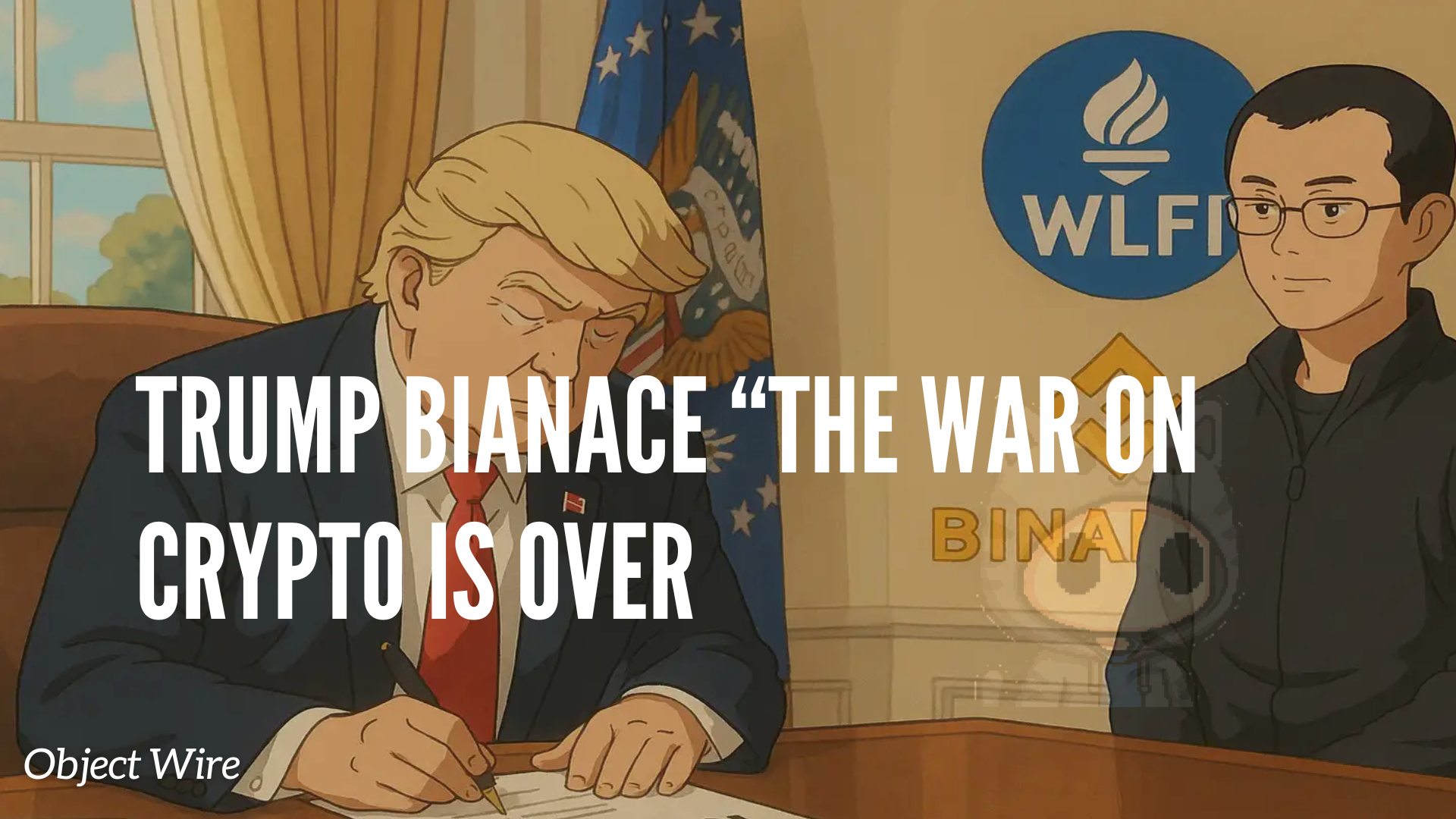historical and Political News WIRE
timeless explainers that provide context, background, and insight into major topics

Pardon of CZ from Trump is a Conflict of Interest and the timeline invites scrutiny: Binance's USD1 integration predates the pardon by five weeks, but lobbying ramps up questions. In September 2025, Binance retained Checkmate Government Relations for $450,000 monthly, targeting "executive relief" and crypto policy at

China’s Ban on Rare Earth Minerals Exports to the U.S. for Military Purposes: What happens when the world’s tech superpower cuts off the minerals fueling everything from fighter jets to smartphones? In December 2024, China banned exports of gallium, germanium, and antimony to the United States for military purposes, escalating a trade war sparked by U.S. tariffs and chip restrictions. With China controlling 91% of global rare earth element (REE) refining, this move threatens U.S. defense and tech sectors. Is this a calculated strike to exploit American vulnerabilities, or a risky escalation that could backfire? China’s Strategic Ban: Targeting U.S. Military Capabilities On December 3, 2024, China’s Ministry of Commerce announced a ban on exporting gallium, germanium, and antimony to the U.S. for military applications, citing national security and non-proliferation. This followed earlier April 2025 restrictions requiring export licenses for seven REEs—samarium, gadolinium, terbium, dysprosium, lutetium, scandium, and yttrium. The bans, detailed by Newsweek , respond to U.S. tariffs of up to 54% and restrictions on Chinese chip-making technology. By targeting “dual-use” minerals critical for both civilian and military tech, China aims to choke U.S. defense supply chains. Can America pivot quickly, or will this expose a dangerous dependency? China’s ban targets materials used in 78% of U.S. defense platforms, per CSIS data. Why These Minerals Matter: The Backbone of Defense and Tech Gallium, germanium, and antimony are not household names, but they’re indispensable. China produces 94% of global gallium, 83% of germanium, and 56% of antimony, per a 2023 EU study. Their roles include: Gallium : Essential for semiconductors in radar systems, LEDs, and solar cells. Germanium : Critical for infrared optics in night-vision systems and fiber optics for 5G. Antimony : Used in batteries, flame retardants, and military sensors. REEs like dysprosium and terbium enhance magnets in F-35 jets (920 lbs of REEs per unit) and missiles, with China refining 99% of heavy REEs globally. The U.S. Geological Survey notes that 70% of U.S. REE imports come from China, highlighting a critical vulnerability. Will this ban cripple U.S. military readiness, or spur innovation? Research Insight: The F-35 program alone relies on 417 kg of REEs per jet, per RAND. China controls 90% of global rare earth magnet production, vital for defense tech. The Center for Strategic and International Studies warns of a “critical chokehold,” with global automakers like Volkswagen already facing disruptions. Can the U.S. diversify fast enough to avoid a crisis? U.S. Counters by Building a Domestic Supply Chain The U.S. is fighting back. Executive Order 14241, issued in March 2025, fast-tracks mining permits via FAST-41, shaving 15-18 months off project timelines. The Department of Defense has invested $439 million in domestic REE facilities, including MP Materials’ Mountain Pass mine and a new $6.1 million Ramaco Brook Mine in Wyoming. “Friend-shoring” with Australia and Ukraine aims to diversify supply, but the U.S. holds just 1.5% of global REE reserves. Recycling and alternative materials are being explored, yet scaling remains years away. Will these efforts break China’s grip, or fall short? Research Insight: MP Materials produces only 1,000 tons of magnets annually vs. China’s 300,000 tons. As the trade war simmers, strategic investments and global partnerships are critical to reclaiming control.

Imagine a school district spending nearly three-quarters of a million dollars on jerk chicken and plantains from one restaurant in a single year. That’s exactly what the NYC Department of Education (DOE) did in fiscal year 2025, channeling $745,823 to Fusion East, a Caribbean and soul food restaurant in Brooklyn. Flagged by City Comptroller Brad Lander, this expenditure has sparked outrage over fiscal oversight in the nation’s largest school district. Is this a commendable effort to support minority businesses or a glaring lapse in accountability? Let’s unpack the Comptroller’s report, NYC Comptroller report shows shadowy dealings with Fusion East On August 1, 2025, a New York report revealed the DOE’s $745,823 expenditure at Fusion East, citing expense records and communications obtained by the Comptroller’s office. The investigation, led by Deputy Comptroller Charlette Hamamgian, revealed a dramatic spending increase: $5,300 in 2022, $81,637 in 2023, $470,686 in 2024, and $745,823 in 2025—a 14,000% surge over three years. Read the full report. The probe began with 13 invoices totaling $19,998 from Brownsville Collaborative Middle School for events between August 28 and September 6, 2024, most exceeding NYC Comptroller Directive #6 per-person spending limits. Further scrutiny uncovered $1.4 million spent at Fusion East since 2016, raising concerns about mayoral oversight. Is this an isolated issue or a symptom of deeper systemic flaws? Breakdown of the $745,823 Caribbean Soul Food Expenditure Of the $745,823 spent in 2025, $618,000 came from Brownsville Collaborative Middle School, with the remainder spread across other DOE schools. The funds supported: Professional Development: Catering for educator workshops, including breakfasts and lunches for large groups. Administrative Meetings: Monthly DOE staff gatherings, often ordering Fusion East’s $5 special (jerk chicken, rice, and sides) for 200-300 people. Community Events: Student award ceremonies and parent engagement activities, leveraging Fusion East’s East New York location. Fusion East, a Minority and Women-owned Business Enterprise (MWBE), aligned with Mayor Eric Adams’ goal to increase MWBE contracts. Public and Official Reactions to DOE’s Fusion East Spending The revelation ignited fierce reactions. Comptroller Brad Lander’s spokesperson, Sara Azcona-Miller, called the spending “glaring” evidence of inadequate oversight, noting that $745,823 could fund school supplies for countless teachers and students. On X, users like @NYCWatchdog labeled it “wasteful,” demanding audits , while @BrooklynParent acknowledged catering needs but questioned the scale, citing underfunded classrooms. DOE officials, led by Chief Procurement Officer Elisheba Lewi, admitted in a March 18, 2025, response to Lander that Brownsville Collaborative violated purchasing rules. Procurement Practices Under Fire in NYC Schools The Fusion East case exposes flaws in DOE procurement. NYC Comptroller Directive #6 sets strict per-person spending limits, yet multiple invoices exceeded these, suggesting weak oversight. The DOE’s failure to conduct an agency-wide review of Fusion East transactions, as noted in its May 30, 2025, letter, raises concerns about systemic issues. Competitive bidding and transparent vendor selection could have identified cheaper alternatives, especially given Fusion East’s ties to Adams’ advisory boards. Oversight and Accountability: A Call for Reform Effective oversight is critical for the DOE, managing a $38 billion budget for 1,600 schools and nearly 1 million students. The Fusion East scandal reveals gaps in checks and balances, with Lander’s office pushing for stricter controls. A 2025 poll found 65% of New Yorkers support tighter DOE oversight, reflecting public demand for accountability. This sentiment aligns with broader concerns about public spending, as seen in discussions about fraudulent charges impacting 26% of Americans in 2023. Future Implications: Reforming NYC Education Spending The Fusion East scandal could reshape NYC education spending policies. Potential reforms include: Enhanced Audits: Mandatory agency-wide reviews of vendor transactions to ensure compliance. Spending Caps: Stricter enforcement of Directive #6 limits to prevent excessive expenditures. Community Input: Engaging parents and teachers in budget priorities to align spending with educational needs. The controversy may pressure Adams’ administration, facing a 2025 mayoral race, to prioritize classroom funding. Will this scandal spur meaningful change, or remain a cautionary tale?

On June 17, 2025, the U.S. Senate passed the GENIUS Act , a landmark bill celebrated as a win for the cryptocurrency industry. What Are Stable Coins? Sstablecoins are digital currencies pegged to the U.S. dollar are now to be backed by U.S. Treasury bonds, The Guiding and Establishing National Innovation for U.S. Stablecoins Act (The GENIUS Act) aims to bring stability and legitimacy to the volatile crypto market. However, beneath the promise of regulated digital dollars lies a troubling possibility: the GENIUS Act could sow the seeds for the next global economic crash. This article explores the Act’s mechanics, its ties to the U.S.’s $34 trillion debt , and why it raises serious concerns for global financial stability. The Roots of Stablecoins and the GENIUS Act Cryptocurrencies emerged with Bitcoin in 2008, envisioned as a decentralized “digital gold” free from government control, as outlined in Satoshi Nakamoto’s whitepaper . Unlike traditional currencies tied to national economies, Bitcoin’s value was meant to be determined by a globalized computer system, akin to a modern gold standard. However, the crypto market has since become a speculative playground, with volatile prices resembling a casino more than a stable store of value. To address this, stablecoins were created—cryptocurrencies pegged to stable assets like the U.S. dollar to attract cautious investors. The GENIUS Act takes this further by mandating that stablecoins be backed by U.S. Treasury bonds, low-risk securities that finance government spending. Using blockchain’s secure, transparent ledger, the Act positions stablecoins as a trusted medium for global payments, savings, and programmable financial systems. But tying digital dollars to the U.S.’s massive debt introduces risks that could ripple worldwide. How the GENIUS Act Works Under the GENIUS Act, stablecoins function like casino chips: you exchange dollars for digital tokens, use them for transactions, and the issuer guarantees their 1:1 redemption for dollars. Major corporations like Amazon and Walmart are reportedly planning to issue their own stablecoins, raising questions about interoperability. Will Amazon’s tokens be accepted at Walmart? If every company creates its own digital currency, how will consumers navigate this fragmented system? The Act’s regulation aims to ensure stability by requiring issuers to hold sufficient Treasury reserves. However, this doesn’t eliminate risk. The 2022 Terra crash in South Korea , which erased nearly half a trillion dollars from crypto markets overnight, shows what happens when a stablecoin issuer fails to maintain reserves, as detailed in this CoinMarketCap analysis . The Risk of a Global Financial Crisis The GENIUS Act’s reliance on Treasury bonds ties stablecoins to the U.S.’s $34 trillion debt, as reported by the Federal Reserve Bank of St. Louis . Imagine a major company issuing $100 billion in stablecoins backed by Treasuries. If its finances falter—due to mismanagement or economic downturn—investors may doubt its ability to redeem tokens at full value. A rush to cash out would force the company to sell Treasuries, depressing bond prices and driving up U.S. interest rates. A sudden spike in interest rates could destabilize banks and governments globally, triggering a financial crisis. This scenario echoes Argentina’s 1991–2002 peso-dollar peg, which collapsed under economic pressure, as noted in IMF reports . The GENIUS Act’s structure makes such a crisis plausible if issuers overextend their stablecoin supply. No Guarantee of Safety Proponents argue that the GENIUS Act’s regulatory oversight will prevent such disasters. Yet, U.S. regulators have a spotty track record. The 2023 Silicon Valley Bank collapse, caused by undetected exposure to interest rate hikes, exposed weaknesses in financial oversight, as covered by Reuters . If multiple companies over-issue stablecoins, regulators may fail to act in time, allowing a crisis to unfold. Broader Implications for Global Finance The GENIUS Act could reshape global finance in unintended ways. Emerging markets adopting stablecoins may become more dependent on U.S. monetary policy, reducing their financial sovereignty. Blockchain’s decentralized promise clashes with the Act’s centralized oversight, potentially stifling crypto innovation. Most critically, linking digital money to U.S. debt ties personal wealth to national fiscal health, creating vulnerabilities if Treasury markets falter. Navigating the Future The GENIUS Act marks a pivotal moment, blending digital dollars, U.S. debt, and blockchain into a new financial paradigm. While it strengthens the dollar’s global role, it risks sparking a crisis if mismanaged. To thrive in this evolving landscape, individuals must understand stablecoins, Treasuries, and debt dynamics. Resources like the U.S. Treasury’s securities overview and blockchain tutorials can help. The GENIUS Act promises a stable digital future but carries hidden risks. By staying informed, readers can navigate this transformed financial era and advocate for policies that balance innovation with stability.

As of May 31, 2025, reports of financial misconduct, unauthorized fund diversions, and aggressive interventions by the Department of Government Efficiency (DOGE) have sparked legal battles and public outcry. This article explores these allegations, the key players involved, and their implications for U.S. foreign policy, addressing longtail keywords like “USIP corruption allegations 2025,” “USAID financial mismanagement issues,” and “DOGE takeover attempts.”
